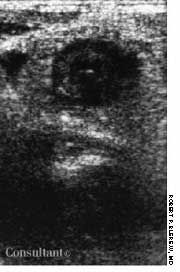- Clinical Technology
- Adult Immunization
- Hepatology
- Pediatric Immunization
- Screening
- Psychiatry
- Allergy
- Women's Health
- Cardiology
- Pediatrics
- Dermatology
- Endocrinology
- Pain Management
- Gastroenterology
- Infectious Disease
- Obesity Medicine
- Rheumatology
- Nephrology
- Neurology
- Pulmonology
Crohn Disease
Shortly after awakening, a 17-year-old man experienced acute onset of severe pubic area pain.

Shortly after awakening, a 17-year-old man experienced acute onset of severe pubic area pain. He had a normal bowel movement, ate very little breakfast, and was not nauseated. He described an 18-month history of “a nervous stomach,” with bowel movements frequently after meals and a nondescript abdominal pain, which had been diagnosed as irritable bowel syndrome.
His temperature was 36.2°C (97.1°F), and the physical examination revealed localized tenderness at McBurney point. White blood cell count was 20,300/µL, with 91% neutrophils and 9% lymphocytes. Abdominal ultrasonography demonstrated a bull's eye typical of acute appendicitis.
At surgery for anticipated appendectomy, writes Robert P. Blereau, MD, of Morgan City, La, the distal 8 to 10 inches of ileum were acutely inflamed and sausage-shaped. Approximately 1 inch of ileum adhered to the anterior abdominal wall at the suprapubic area-the apparent cause of the patient's pubic area pain. The appendix was retrocecal and normal. An appendectomy was performed, and the patient was treated initially with intravenous methylprednisolone, 40 mg q8h, followed by oral methylprednisolone, 32 mg every morning, as he improved.
Dr Blereau points out that the bull's eye sign on abdominal ultrasonography is highly suggestive of acute appendicitis and terminal ileitis (Crohn disease). An unusually large normal appendix also may present with the same picture.
